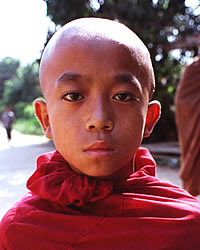Taungtha in Myanmar (Burma)

Photo Source:
Asia Harvest-Operation Myanmar
|
Send Joshua Project a map of this people group.
|
| People Name: | Taungtha |
| Country: | Myanmar (Burma) |
| 10/40 Window: | Yes |
| Population: | 31,000 |
| World Population: | 31,000 |
| Primary Language: | Chin, Rungtu |
| Primary Religion: | Buddhism |
| Christian Adherents: | 0.00 % |
| Evangelicals: | 0.00 % |
| Scripture: | Translation Started |
| Ministry Resources: | No |
| Jesus Film: | No |
| Audio Recordings: | No |
| People Cluster: | Kuki-Chin-Mizo (Zo) |
| Affinity Bloc: | Tibetan-Himalayan Peoples |
| Progress Level: |
|
Identity
The Taungtha numbered 5,704 people in the 1901 census, increasing to 11,187 by 1931. Of those, 11,186 identified as Buddhists and just one as an animist. Since that time, however, they have not been recognized as one of Myanmar's official 135 ethnic groups due to their assimilation to Burmese culture and language. Historically and linguistically the Taungtha are part of the Chin race, but today they have dropped all reference to being Chin and just call themselves Taungtha. One source states: “The Taungtha are in fact Burmanized Chins. Like other Chin-speaking groups living outside of Chin State, they do not self-identify as Chin. They formerly identified as Taungtha on documents until stricter enforcement of the recognized ethnic groups in recent times required them to begin self-identifying as Bamar (Burmese).”
Location: The 30,000 Taungtha people inhabit 48 villages in central Myanmar's Magway Region. They are distributed across three townships, with 23 villages in Htilin, 22 in Saw, and three villages in Gangaw Township. Until 2003 these areas were part of Pakokku District, but the area was reorganized and became part of the new Gangaw District. The Myittha River flows through Taungtha territory, which sits at the start of the Chin Hills at the western edge of the Magway Region. The Taungtha people are one of only a few Chin-related groups that do not reside at least partially within Chin State.
Language: Despite their reluctance to be identified as Chin, the Taungtha language, which is also known as Rungtu, is clearly part of the Southern Chin branch of the Tibeto-Burman linguistic family. Although it is also related to the Rawngtu language spoken across the border in Chin State, the two now share only a 60 percent lexical similarity. Burmese has taken over as the language of choice and education among the Taungtha, with a 2016 study describing the unwritten Taungtha language as “moribund and endangered,”2 and spoken by only 4,000 Taungtha people at the time. Among those who can still speak their mother tongue, the language divides into three dialects labeled Northern, Central and Southern.
History
The Taungtha claim descent from the Pyu people, who many consider were the first ethnicity to establish city-states in Myanmar. The Taungtha believe they lived further south near Mt. Popa during the Pagan Kingdom (AD 849 - 1287), which “earned the moniker ‘Taungtha' (literally ‘sons from the south' or ‘sons from the hills').”4 Culturally, the Taungtha share many similarities with the Asho Chin people, revealing a past link between the two groups.
Customs
Most Taungtha people are engaged in agriculture, cultivating rice, beans, pepper, onions, oranges, and lemons. Their homes are wooden structures built without the use of nails but fastened together by wooden hinges. As they have gradually assimilated into the Burmese language and culture, the clothing worn by Taungtha men has become indistinguishable from the Burmese, but women traditionally wore a costume “consisting of a red shawl worn as a body wrap, over a long white robe or gown. Historically, the color of the shawls reflected a female's relative age and marital status: girls wore white shawls, single young women wore red shawls, while married women wore darker-colored shawls.”
Religion
The Taungtha people have been Buddhists for centuries, and today they practice a syncretic Buddhist-animist religion featuring the worship of spirits, which is technically not permitted in Theravada Buddhism. As part of their desire to distance themselves from their Chin ancestry and heritage, it appears the Taungtha have rejected Christianity, and no sources indicate the presence of any Christians at all among them.
Christianity
The unreached Taungtha are considered resistant to the Gospel, and efforts by other Chin Christians to share the Gospel with them have so far failed to bear fruit. No printed, video, or audio Christian resources are available in the Taungtha language, so outreach to them is probably best done using Burmese materials.